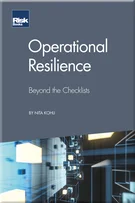Evolving from a plain vanilla to a state-of-the-art model
Introduction
Challenges of operational risk advanced capital models
Part I: Capture and Determination of the Four Data Elements
Collection of operational loss data: ILD and ED
Scenario analysis framework and BEICFs integration
Part II: General Framework for Operational Risk Capital Modelling
Loss data modelling: ILD and ED
Distributions for modelling operational risk capital
Scenario analysis modelling
Exposure-based approaches
BEICFs modelling and integration into the capital model
Hybrid model construction: Integration of ILD, ED and SA
Derivation of the joint distribution and capitalisation of operational risk
Backtesting, stress testing and sensitivity analysis
Regulatory approval report
Evolving from a plain vanilla to a state-of-the-art model
Part III: Use Test, Integrating Capital Results into the Institution’s Day-to-day Risk Management
Strategic and operational business planning and monitoring
Risk/reward evaluation of mitigation and control effectiveness
Appendix 1: Credibility theory
Appendix 2: Mathematical optimisation methods required for operational risk modelling and other risk mitigation processes
Business risk quantification
Previous chapters have described the components of a state-of-the-art operational risk capital model. However, institutions generally start with much simpler models and progressively evolve by adding the analytics required for much more realistic and forward-looking capital estimates. In this chapter, we look at the progressive steps that an institution can take to evolve the model from plain vanilla to fully developed.
The process of building a state-of-the-art operational risk capital model that accurately reflects a forward-looking risk profile has various phases, which include an initial regulatory approval of the capital model. Although there is no equal case in how an institution arrives at a fully developed capital model, Figure 13.1 presents a common path.
Along the implementation of a mature operational risk capital model, institutions pass by the different typical model development stages summarised in this chapter, which are based on the experiences of the author. The capital model enhancement drivers are the understanding and automation of the required analytical processes, as well as the integration of the capital results into daily management. The last, in turn
Copyright Infopro Digital Limited. All rights reserved.
As outlined in our terms and conditions, https://www.infopro-digital.com/terms-and-conditions/subscriptions/ (point 2.4), printing is limited to a single copy.
If you would like to purchase additional rights please email info@risk.net
Copyright Infopro Digital Limited. All rights reserved.
You may share this content using our article tools. As outlined in our terms and conditions, https://www.infopro-digital.com/terms-and-conditions/subscriptions/ (clause 2.4), an Authorised User may only make one copy of the materials for their own personal use. You must also comply with the restrictions in clause 2.5.
If you would like to purchase additional rights please email info@risk.net








